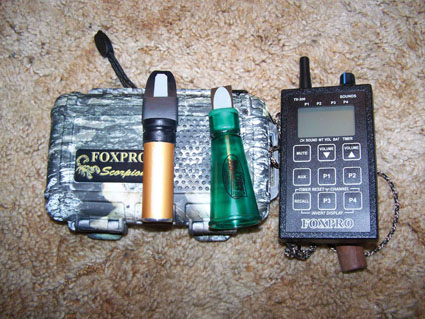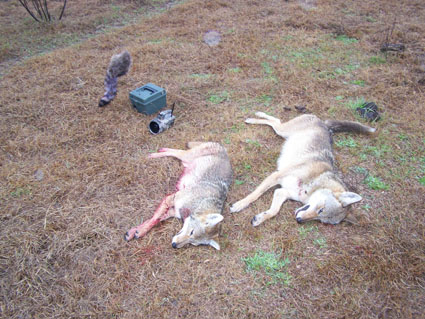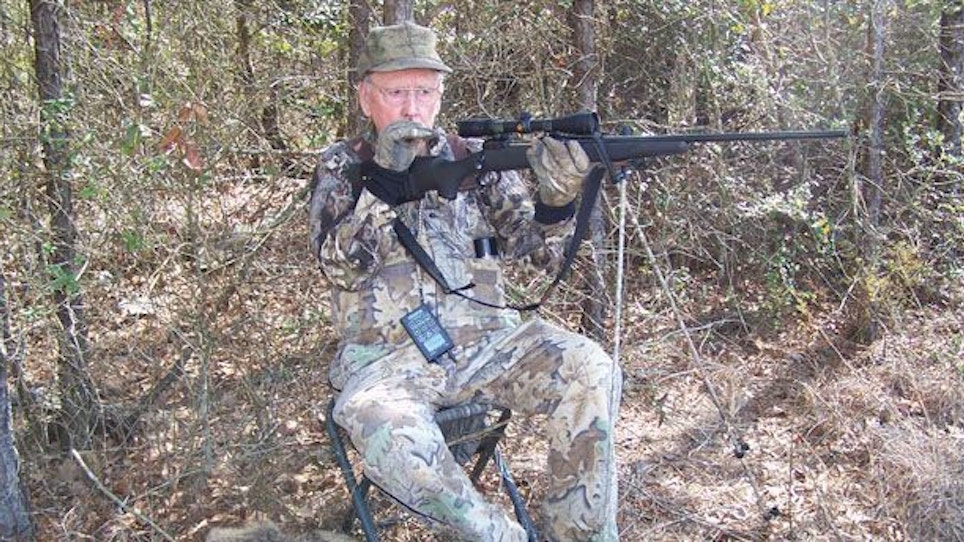When I began calling for coyotes and predators, I only used prey distress calls. As time went on I expanded my repertoire to include coyote talk. Research taught me there are at least two dozen coyote vocalizations, all saying something specific. I am still learning and only use the few that are effective for me. I suspect I haven’t succeeded with the others because I don’t know what they mean or when to use them. There are callers who use more, but I have only mastered a few.
If I have learned anything at all, it is that during the breeding season—January, February and March, in my area — coyote vocalizations are far more effective than prey distress calls. Sure, I often use a prey distress to close the deal, but it is usually coyote talk that gets them there in the first place.
Male Challenge
This call says two things, maybe more. First: “This is my turf, my food source, my mate and my kids and I’ll whip any other dog that trespasses.” It can also say, “I know this ain’t my bailiwick, but I think I can take the big guy who lives here.”
When I began using the male challenge, I expected responses only from alpha males. This is often the case, but with coyote hunting, nothing is absolute and I have been pleasantly surprised by having females as well as a few young males come in, hackles bristling
Conversely, a juvenile male will likely — but not always — tuck his tail and run from the sound of an aggressive male challenge. This sound is usually a low-pitched, chopped-off howl, dripping with frustration and anger. Use this sound in a higher pitch and the alpha female might come looking for a fight, leading me to believe that there is such a thing as a female challenge howl.
Substance was lent to this theory one summer night. I took a neophyte caller to an area where there is a den. The new caller wanted to hear what a coyote howl sounds like. While Eastern coyotes might respond to a howl by coming to it, it is rare for one to respond vocally during daylight hours. After dark, things change.
Slipping quietly to within 400 yards of the den, I offered a loud lonesome howl. We immediately heard two choppy challenge howls, one higher-pitched than the other. I believed that this was the alpha male and the alpha female in chorus.
One of the benefits of using canine vocalization to call coyotes is that responders often ignore the wind direction. Conversely, the majority of coyotes responding to a prey distress cry circle and come in from downwind.
 Interrogation Howl
Interrogation Howl
I’m not smart enough to give you an example of this vocalization with words. A tape or DVD of coyote sounds will serve you much better.
The interrogation howl says, “Is there anyone out there? Where are you?” This sound serves more than one purpose. The howler could be a transient nomadic interloper checking out the location to see if there are any resident coyotes around. Having had his butt kicked before by trespassing into another coyote family’s territory, he is just playing it safe. Such a coyote, upon getting a challenge as an answer, will likely skirt the area and move on.
On the other hand, this coyote could be looking for company, or a mate. If he is too young for mating, he might simply be looking for an area where there are no other coyotes, having been kicked out of the family territory because he was no longer welcome.
Another possibility is that this coyote is in its own territory, got separated from its crew during a long night of hunting, and is trying to make contact with the family group. In such a case, he will likely get a friendly answer. Coyotes know the voice of a family member and would welcome a lost cousin.
Threat-Bark Howl
When I was loading up my e-callers with all available coyote sounds, I came upon the “threat-bark” howl. Perhaps some callers have been successful with this one, but I have not.
It says — among possibly other things — “I don’t want to socialize, so you best keep your distance.” Despite having used it several times, I only got one response. Using the interrogation howl, I received a vocal response — not often the case — in the form of a male challenge. I responded in like manner.
For 20 minutes we traded challenges and nothing happened. I waited 10 more minutes in silence and gave him another challenge. He countered with three threat-bark howls. I responded in kind. He never came in or uttered another sound.
Female Invitation
This call has brought in more coyotes for me than any other.
The primary responders are males but I also have killed females and juveniles using the female invitation. Most coyotes that answer are not spooked and don’t circle downwind. They trot or walk in, rarely with an aggressive demeanor
The rare exception occurs when the female invitation is used in an established territory inhabited by a mated pair. In this case, the resident female might not be so hospitable. Responders to the interrogation howl are easily stopped for a standing shot. They rarely bolt and run when brought to a halt with a bark or whistle.
The Coyote Serenade
 This is the chilling sound made when all the dogs in the pack begin to howl at once. There are never as many as one would think because three coyotes in concert sound like a dozen.
This is the chilling sound made when all the dogs in the pack begin to howl at once. There are never as many as one would think because three coyotes in concert sound like a dozen.
It is a good locator, since it will often — not always — be answered by another pack in an adjacent territory. This will tell you the general area where the other pack lives and is a good guide to future hunting. The serenade is not a calling tool. Use it as a locator only at night because Eastern coyotes are not so vocal in daylight.
Yips
These are similar to barks except higher-pitched and very short. Coyotes hunting together will “yip” when chasing prey. This is not something I use every day. In fact, the only times I have successfully used yips was when I heard coyotes chasing prey and I gave them some of my own yips.
In this situation, one or more of the juveniles might break away from the pack and come in. This is not a high-percentage call, but worth having in your arsenal.
Lonesome Howl
Just that: a non-aggressive, medium-volume, high-pitched howl. There is no sense of urgency and no threat. It simply says, “I am bored and I surely could use some company.” It”s similar to the female invitation howl except that it is laid-back and is neither demanding nor pleading.
My success with this one comes when I howl just once, wait five minutes and howl again. I simply wait, listen and watch. If nothing happens in 10 minutes, I switch to prey distress.
Pup Distress
Who can resist a youngster in distress? Males and females, young and old, respond to the sound of an injured pup. Bobcats and foxes also come running. Coyotes don’t seem to know or care what time of year it is.
Theoretically, pup distress calls will only be heard from April to September. Otherwise, they aren’t pups any more. Still, coyotes respond any time of the year. This is a tremendously effective calling sound.
Putting It All Together
Coyotes have exceptional hearing. If you have just one challenge howl on an e-caller, the local dogs will soon memorize it and know it is a fake. The same applies to female invitation and interrogation howls.
Some e-caller manufacturers have an extensive sound library with multiple, but different, examples of the same calls. Regarding the aforementioned calls, I now have alternates to use in those areas where the coyotes are educated.
Prey distress calls are wonderfully effective, but you greatly increase your take if you add coyote vocalizations and use them at the right times.






